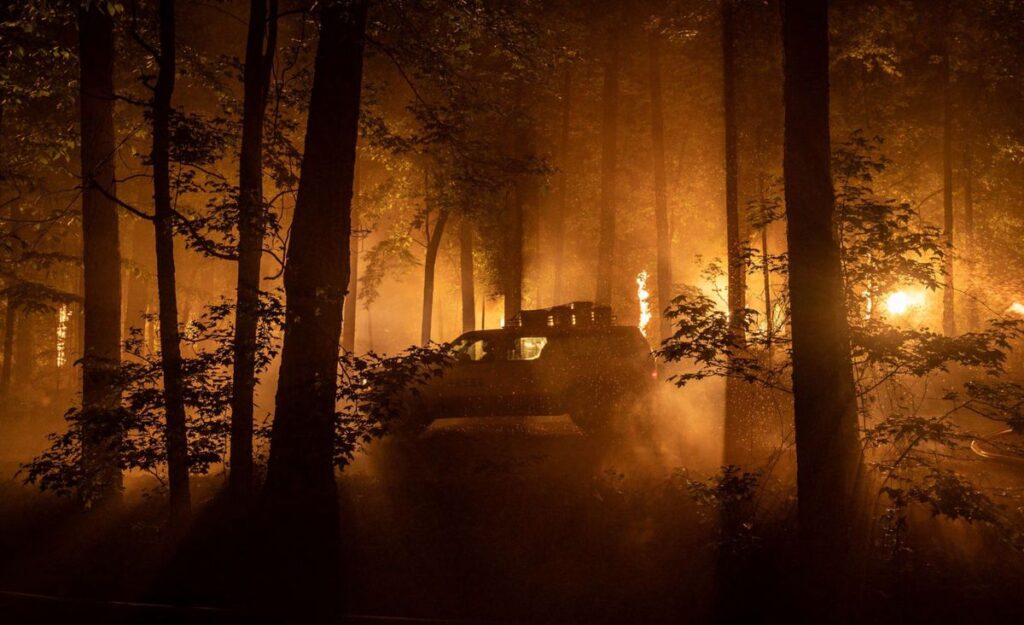Even though Alex Garland’s near-future catastrophe movie Civil War takes place during an American insurrection aimed at forcing an autocratic, democracy-destroying president out of power, it focuses more on the journalists covering the war than on who’s fighting who. That, Garland tells Polygon, was a choice he made because he wanted the story to be about why reporters are a critical part of a functioning society. That same agenda also shaped the look of Civil War: The movie is largely seen through the eyes of two photojournalists, veteran Lee Miller (Kirsten Dunst) and cub reporter Jessie (Cailee Spaeny). Their intent focus on capturing the perfect image made it important for Civil War to be visually striking.
One particular standout sequence comes late in the movie, when Lee, her reporter partner Joel (Wagner Moura), and Jessie silently drive through a burning forest, one of the casualties of the war. The characters exchange grim, weary glances in the orange-lit dark as the fires burn around them. It’s a beautifully shot scene, and Polygon asked Garland how he approached capturing it on camera.
Image: A24
“There’s an easy answer to that, because I’ve never shot-listed,” Garland told us. “I don’t ever arrive on set with a plan. That’s for complicated reasons, which is usually to do with acting, and not wanting to tell an actor where to sit. I don’t want to say, ‘Stand by the window, because I’ve got a great shot.’ If they don’t want to stand by the window, then I’ve got a problem with the actor, a sort of unnecessary tension. I’ve never come to a scene yet where actors aren’t doing the thing they want to do and it’s impossible to shoot it. So I don’t worry about shot lists.”
Instead, he talked to the SFX team about what he wanted for the sequence, and he says they told him, “‘We are going to nail this. We know exactly what we’re going to do. We’re going to try something that hasn’t been done. Trust us.’
“That’s always my favorite thing to hear from a department,” Garland laughs.
When he arrived to shoot the sequence, Garland says the effects crew had set up a series of artificial trees in the forest, rigged to generate flames at the flip of a switch. “There was a fire department and big hoses ready to put everything out if it got out of control,” he says. “But the really magic thing they did was — directly ahead of the hero vehicle with the actors in it, there was a truck. And in the back of the truck, there was a large metal cylinder that they created, which generated a massive amount of heat, like you would in a kiln or a pizza oven.”
Garland says the team demonstrated how they’d use dry charcoal to create the flares of light and curtains of bright embers that would rain down on the car during the shoot. “They’re all there in fireproof suits and visors and big, heavy gloves,” he says. “And they would chuck these bundles of charcoal sticks [into the cylinder]. In that level of heat, they just immediately exploded into showers of sparks. I can really say this was the most hypnotically beautiful thing I’ve ever seen on a film set. It was a completely practical effect, and it was dizzying.”
Ironically, having the effect work so well initially made Garland uncomfortable. “At first, it produced a surge of anxiety: What if we can’t do justice to this imagery?” he says. “[Cinematographer Rob Hardy] and I were really struggling in the first few moments — which is to say, the first 45 minutes or something — because it felt transcendent, and beyond us. And then we just relaxed and realized, this isn’t a magic moment. These guys are able to do this again and again, and we should just calm down and find the shots. And we gradually started putting the sequence together. So the credit there really belongs to that SFX team.”
Civil War is in theaters now.

